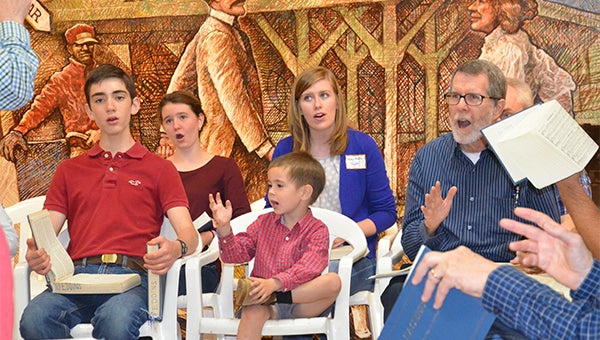SACRED SONGS: Museum’s shape note singing restores history
Published 3:00 am Tuesday, February 28, 2017

The Pioneer Museum of Alabama highlighted the human voice on Saturday at its 8th anual All-Day Sacred Harp Singing. The event brought bak the history of “shape-note” singing that identifies what note singers are meant to sing. Ken Sundberg organized the event and said Sacred Harp singing is the easiest way to learn how to sing.
The Pioneer Museum of Alabama was alive with the sound of music Saturday and the singing was loud and joyful.
The museum was the host site of the 8th Annual All Day Sacred Harp Singing and the singers ranged in age from four to 84. The all day singing was organized by Ken Sundberg of Troy, who is an advocate for Sacred Harp singing as well as a “harp.”
“The harp in Sacred Harp refers to the human voice –the musical instrument given at birth,” Sundberg said.
The name of the tradition comes from the title of the shape-note book, “The Sacred Harp.”
“The shape-note music notes are printed in special shapes that help the reader identify the musical scale,” Sundberg said. “Sacred Harp has four shapes and each of the four shapes is connected to a particular syllable, fa-sol-la or mi. With those four notes, singers are able to cover the full musical scale.”
For some of the “listeners” at Saturday’s Sacred Harp Singing, that sounded complicated.
“Not so,” said Tim Taylor of Frisco City. “Sacred Harp Singing is the easiest and best way you can learn to sing. Back a long time ago, when people could read only a little or not at all, they could quickly learn to sing just by the shape of the notes. It’s a good system to learn the pitches. And, I don’t know of a better way to spend a day than at a singing like this. We sing until our voices give out and then we go home and start looking forward to the next singing.”
Taylor said it’s encouraging to see so many young people at shape note singings.
“This kind of singing, four notes and seven notes, is a part of our history,” he said. “It’s our heritage, our roots. We don’t need to let it die and it will be up to these young singers to keep it going.”
Jason Smith of Moundville, 36, agreed that shape note singing must survive. “I’ve been singing for about eight years and I’m seeing more young people at these singings,” he said. “I think there’s beginning to be more interest in our heritage and, not just to read about it, but to experience it. And, what better way to learn about the old traditions and ways of doing things than to experience them. You can’t really know about Sacred Harp until you experience it.”
Wayne Jones of Opp was raised up singing fasola. He fell away from it for a while. “But I came back,” he said with a smile. “I think most people do. As for those who don’t know about Sacred Harp, I always tell them that, if they’ll come to three Sacred Harp singings in a row, they’ll be hooked.”
Linda Steed of Brundidge attended Saturday’s Sacred Harp Singing, her first at the museum but she is a student of the Ramer Baptist Church Singing School. “When I was growing up, we didn’t have a choice; we went to singing school,” Steed said laughing. “I really enjoyed hearing Sacred Hard sung again and I was amazed to see such young children interested in that kind of music.”
Steed said it was interesting to see such the wide range of ages at the singing. “From little children to middle aged people to senior adults,” she said. “It was good to see that so many people are interested in shape note singing. We all need that kind of enrichment because shape note singing is a part of our history. We don’t have to be able to sing it to appreciate it.”
Steed said those who have arts opportunities, especially those that are historically based, are fortunate and should take advantage of them.




